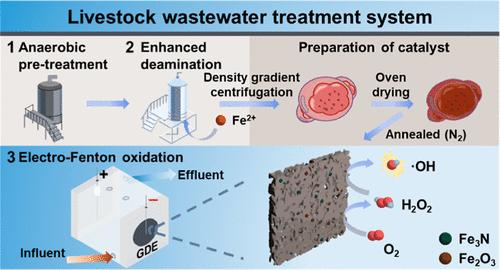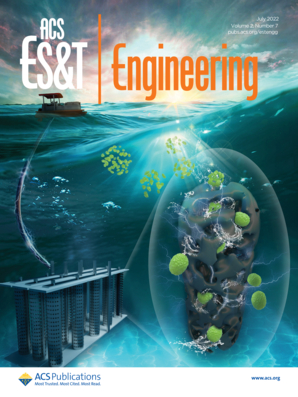生物废料衍生的双位催化剂推动电-芬顿系统以可持续的方式净化禽畜废水
IF 7.4
Q1 ENGINEERING, ENVIRONMENTAL
引用次数: 0
摘要
畜禽养殖业在肉类生产中举足轻重,但其产生的废水污染严重,对环境的可持续发展和公众健康构成了挑战。电-芬顿(EF)工艺能够原位产生和活化过氧化氢,在净化难降解污染物方面前景广阔,但在广泛的 pH 值范围内制造高活性双功能阴极催化剂仍是一个瓶颈。在绿色化学原理的指导下,我们从生物废料中合成了一种双位点催化剂,以促进羟基自由基的产生。结合实验和理论研究发现,Fe2O3 位点通过催化氧还原反应促进 H2O2 生成,而 Fe3N 位点则促进 H2O2 就地活化为羟基自由基。这种集成到气体扩散电极中的电催化剂实现了抗生素污染物在中性 pH 值下的稳定、无曝气矿化,且能耗低,仅为 0.94 千瓦时/克去除的总有机碳。进一步开发的串联系统将 Anammox 生物工艺与 EF 工艺相结合,在实际畜牧业废水的脱氮和三级净化方面都表现出卓越的效率,无需调节 pH 值或添加芬顿试剂。这些发现强调了我们提出的方法在促进可持续废水管理实践中的潜在可扩展性和应用性。本文章由计算机程序翻译,如有差异,请以英文原文为准。

Biological Waste-Derived Dual-Site Catalyst Empowers Electro-Fenton Systems to Sustainably Decontaminate Livestock Wastewater
Livestock and poultry industries are pivotal for meat production, but produced wastewater with heavy pollution challenges environmental sustainability and public health. The electro-Fenton (EF) process, capable of in situ production and activation of hydrogen peroxide, is promising for decontaminating recalcitrant pollutants, yet fabricating a highly active bifunctional cathode catalyst across a broad pH range remains a bottleneck. Guided by green chemistry principles, we synthesized a dual-site catalyst from biological waste to facilitate hydroxyl radical production. Combined experimental and theoretical investigations unveiled that the Fe2O3 sites facilitated H2O2 generation via catalyzing the oxygen reduction reaction, whereas Fe3N sites promoted in situ H2O2 activation into hydroxyl radicals. This electrocatalyst, integrated into a gas diffusion electrode, achieved stable, aeration-free mineralization of antibiotic contaminants at neutral pH with a low energy consumption of just 0.94 kWh/g of removed total organic carbon. The further development of a tandem system that coupled the anammox bioprocess with the EF process exhibited exceptional efficiency in both nitrogen removal and tertiary purification of actual livestock wastewater, obviating the need for pH adjustments or Fenton reagent additives. These findings underscore the potential scalability and application of our proposed approach in promoting sustainable wastewater management practices.
求助全文
通过发布文献求助,成功后即可免费获取论文全文。
去求助
来源期刊

ACS ES&T engineering
ENGINEERING, ENVIRONMENTAL-
CiteScore
8.50
自引率
0.00%
发文量
0
期刊介绍:
ACS ES&T Engineering publishes impactful research and review articles across all realms of environmental technology and engineering, employing a rigorous peer-review process. As a specialized journal, it aims to provide an international platform for research and innovation, inviting contributions on materials technologies, processes, data analytics, and engineering systems that can effectively manage, protect, and remediate air, water, and soil quality, as well as treat wastes and recover resources.
The journal encourages research that supports informed decision-making within complex engineered systems and is grounded in mechanistic science and analytics, describing intricate environmental engineering systems. It considers papers presenting novel advancements, spanning from laboratory discovery to field-based application. However, case or demonstration studies lacking significant scientific advancements and technological innovations are not within its scope.
Contributions containing experimental and/or theoretical methods, rooted in engineering principles and integrated with knowledge from other disciplines, are welcomed.
 求助内容:
求助内容: 应助结果提醒方式:
应助结果提醒方式:


